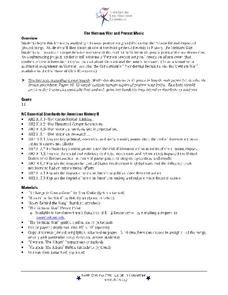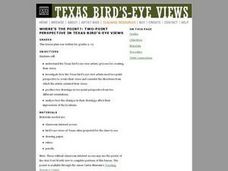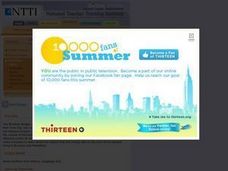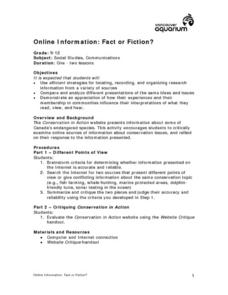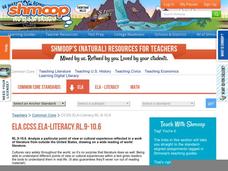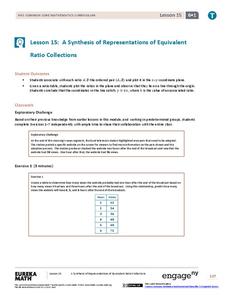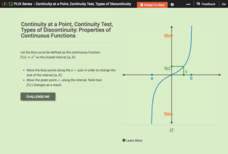Carolina K-12
The Vietnam War and Protest Music
Here's a must-have resource for your Vietnam War curriculum file. Class members view a PowerPoint that details the background of the conflict and then examines the reasons for and the effects of protest songs on American attitudes toward...
Curated OER
Ethical and Critical Thinking: Genetically Modified Food
High schoolers read statements representing different points of view on Genetically Modified Food. They identify the "facts" and "opinions" in each statement, and then briefly summarize the issue of Genetically Modified Food in a short...
Curated OER
Water and Sewage Critical reading
Learners read three articles with different points of view on the water and sanitation issues in the Florida Keys. They identify the facts and opinions in each article and write a summary. In addition, they write an essay expressing...
Curated OER
Where's the Point?: Two-Point Perspective in Texas Bird's-Eye Views
Students investigate how the Texas bird's-eye-view artists used two-point perspective to create their aerial views and consider the directions from which the artists oriented their views. They produce two drawings in tow-point perspective.
Curated OER
"The Big Bridge Scheme": The Building and Impact of the Brooklyn Bridge
Young scholars watch a video and examine archival newspaper articles to study the different points of view about the building of the Brooklyn Bridge. They examine the impact the bridge had on those living in Brooklyn and Manhattan.
Curated OER
Zoom Out
Learners explore visual perception and how objects change as distance changes. In this distance and vision lesson, students practice their scientific inquiry skills. Learners practice drawing objects from different points of view in...
Curated OER
Bronte and Rhys' Portrayal of Bertha
Students, while reading and discussing the two texts by Charlotte Bronte and Jean Rhys, compare/contrast the two main characters and juxtapose them as the same character told from two different points of view. They gain insight of how to...
Curated OER
All the News That's Fit to Blog
Students critique three Web logs, each of which offers first-hand accounts, but reflect different points-of-view, on the war in Iraq; students write a response to one of the entries and analyze what they learned about the war from the...
Curated OER
Talking Heads
Pupils create an imaginary conversation. For this perseverance lesson, students complete a t-chart about words that describe perseverance and words that describe the opposite of perseverance. Pupils sketch a "talking heads"...
Curated OER
Write for Change
Learners discuss and list injustices experienced in the novel "Hoot". They review the different ways letter writing was a part of the novel "Hoot". They choose one issue that is of concern to them and state their viewpoint on the issue....
Curated OER
One Step At a Time
Students examine cultures in Africa. They discover culture includes behaviors, customs and actions. They examine how different people interpret things differently and practice seeing a situation from two points of view.
Curated OER
Online Information: Fact or Fiction
Discuss ways to determine if the information middle and high schoolers gather online is accurate. Using the Internet, they cite two sources that show conflicting points of view on a subtopic of conservation. They summarize and analyze...
Curated OER
"Tomorrow and Tomorrow and Tomorrow"
Do you want to live forever? After reading Kurt Vonnegut’s short story, “Tomorrow and Tomorrow and Tomorrow,” class groups adopt the roles of an ethics committee, product manufacturers, concerned scientists, and potential users of an...
Curated OER
Analyzing a Writer's Stance
Should college admissions decisions be based on whether whose family members attended? Secondary students read and respond to a New York Times article on the issue of 'legacy preferences' in college admissions. Following class...
Shmoop
ELA.CCSS.ELA-Literacy.RL.9-10.6
Being able to identify and understand the point of view of fictional characters across a wide range of time periods, places, and cultures is a skill that is necessary for becoming a proficient reader. It is also a skill identified in the...
EngageNY
A Synthesis of Representations of Equivalent Ratio Collections
Make all the ratio representations fit together. The 15th segment in a series of 29 presents ratio problems to solve. Scholars use a variety of representations to respond to the questions. The problem set has pupils show how the...
PHET
Where to See an Aurora
Where can you see an aurora in North America? After completing an astronomy activity, scholars can locate the exact coordinates. Pupils plot points of the inner and outer ring of the auroral oval and answer questions based on...
CK-12 Foundation
Continuity at a Point, Continuity Test, Types of Discontinuity: Properties of Continuous Functions
Take a closer look at continuous functions within given intervals. Using the parent cubic function, learners explore properties of continuous functions on intervals. Pupils interpret the Intermediate Value Theorem and the Extreme Value...
EngageNY
Connecting Ideas in Primary and Secondary Sources: What Led to the Attack on Pearl Harbor?
Let's make some sense of those thoughts! Scholars continue thinking about the different perspectives on Pearl Harbor. They analyze quotes from War in the Pacific, Day of Infamy, and Fourteen-Part Message. Readers tape each quote to chart...
EngageNY
Studying Conflicting Information: Varying Perspectives on the Pearl Harbor Attack, Part 2
Scholars take another look at Japan's Fourteen-Part Message. They then take turns adding ideas to sentence starters to create ideas about the different perspectives of government. To finish, groups mix and mingle to share their sentences...
Teaching Tolerance
Using Photographs to Teach Social Justice | Advertisements Promoting Activism
Activism can create real change. Class members examine a series of photographs that represent a different form of activism. Individuals then craft a persuasive speech in which they argue why the photo they chose is the best example of...
Curated OER
Abigail in Mourning
People deal with grief in different ways. The series of Abigail Adams' letters in this lesson reveals how she dealt with losing her mother, father, and community members. The included worksheet helps young scholars identify the tone and...
Curated OER
Theft of the Mona Lisa
Learners combine interpretation of the Mona Lisa's visual elements with research information about the artist, and others affected by the painting. Students note that the constructed interpretations differ based on the cultural and...
Curated OER
Workplace Communication from Two Points of View
Students explore the significance of communication in the workplace. In this written communication instructional activity, students review and discuss the attributes of workplace memos prior to writing their own using the provided...


